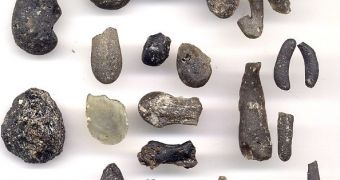A group of investigators from the City University of New York announces the discovery of 800,000-year-old organic materials in tiny pockets inside glass formed following a violent meteor impact.
When space objects hit our planet, they produce very high temperatures, enough to turn sand into glass. Naturally, any materials in the sand are preserved in the glass, which is exactly what happened to ancient cellulose and proteins in the sample the team uncovered in Tasmania.
According to initial estimates, the impactor was between 30 to 50 meters (100 to 160 feet) across, and produced temperatures of up to 1,700 degrees Celsius (3,100 ºF) when it impacted swamps and bogs in Western Tasmania, Australia, around 800,000 years ago.
One of the most interesting implications of the new study is that glass beads containing organic molecules may have been ejected into space, and that they may have ended up on other planets within our solar system. This discovery may highlight a potential mechanism through which life spread through the Cosmos, a theory called panspermia.
For this investigation, which is detailed in a recent issue of the top journal Nature Geoscience, scientists analyzed the quarter-mile (0.4-kilometer) Darwin Crater in Tasmania, where they were able to uncover glass spheres that featured small pockets just micrometers in diameter.
“The reason the glass is so abundant seems likely to relate to the presence of volatiles like water at the surface when the impact occurred,” explains CUNY investigator and lead study author Kieren Howard.
“A bit like when water from your spatula drips into a frying pan, having the right amount of water at the surface during impact may have increased the magnitude of the explosion, and the production and dispersal of the melt,” adds the expert, as quoted by Astrobiology Magazine.
The impactor that produced the Darwin Crater spread glass from the crash site over an area covering 400 square kilometers (150 square miles). This distribution pattern was made possible by the presence of significant amounts of water at the impact site, which was at the time covered in swamps and rainforests.
“I went looking for crystals in the glass, only to discover the spherical inclusions. [This is like setting something in resin or amber – like a scorpion novelty in a glass paperweight,” Howard concludes.

 14 DAY TRIAL //
14 DAY TRIAL //